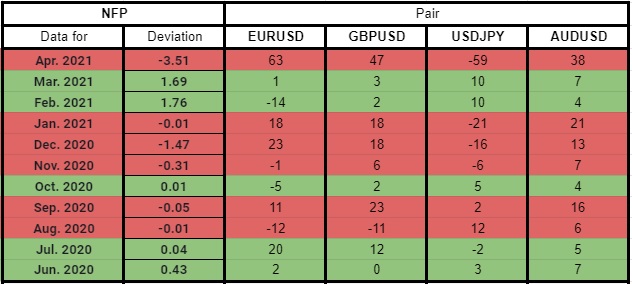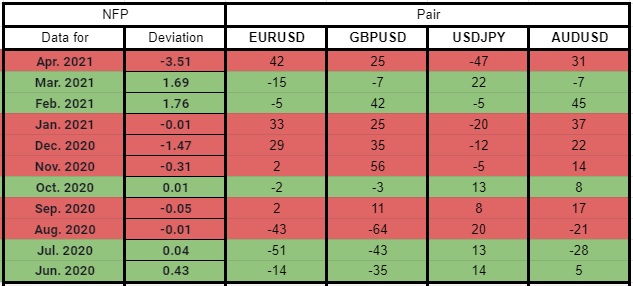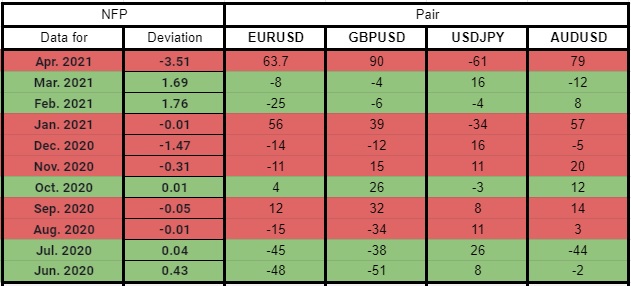- Nonfarm Payrolls in US is expected to rise by 664,000 in May.
- There is a strong correlation between NFP deviations and major pairs' immediate movements.
- A disappointing NFP print is likely to trigger a more significant reaction than a positive one.
The US Bureau of Labor Statistics (BLS) will release the May jobs report on Friday, June 4. Following April’s disappointing figure, investors expect the Nonfarm Payrolls (NFP) to increase by 664,000 and see the Unemployment Rate edging lower to 5.9% from 6.1%.
The general market view is that a positive surprise in the NFP reading is likely to help the greenback outperform its rivals and vice versa. As such, the US Dollar Index, which tracks the USD’s performance against a basket of six major currencies, lost 0.73% on a daily basis on May 7 when the BLS reported that the NFP rose by 266,000 in April to miss analysts’ estimate of 978,000 by a wide margin.
Like this article? Help us with some feedback by answering this survey:
In order to understand how impactful the US jobs report is on the USD’s market valuation, we analyzed the market reaction of four major pairs, EUR/USD, GBP/USD, USD/JPY and AUD/USD, to the previous 11 NFP prints. We omitted the older NFP figures because we believe the numbers registered during the coronavirus outbreak created extreme outliers and distorted the results.
Methodology
The FXStreet Economic Calendar assigns a deviation point to each macroeconomic data release to show how big the divergence was between the actual print and the market consensus. The -3.51 deviation seen in April's NFP reading could be assessed as a relatively big negative surprise. On the other hand, February’s NFP print of 536,000 against the market expectation of 182,000 was a positive surprise with the deviation posting 1.76 for that particular release.
“Deviation: It measures the surprise caused when the Actual data differs from the Consensus. It can oscillate in an open scale usually between -7 and +7.”
Next, we plotted the reaction, in terms of pips, of the major pairs mentioned above 15 minutes, one hour and four hours after the release to see if the general market view held.
Finally, we calculated the correlation coefficient (r) to figure out which major pair had the strongest correlation at which time frame. When r approaches -1, it suggests there is a significant negative correlation, while a significant positive correlation is identified when r moves toward 1.
Results
There were six negative NFP surprises against five positive surprises in the previous 11 releases. On average, the deviation was -0.89 on disappointing prints and 0.78 on upbeat figures. 15 minutes after a negative surprise, the average gains in the EUR/USD, GBP/USD and AUD/USD were 17, 16.8 and 16.8 pips, respectively, while USD/JPY lost 14.6 pips. On the other hand, EUR/USD, GBP/USD, USD/JPY and AUD/USD rose 0.8, 3.8, 5.2 and 5.4 pips, respectively, on average following positive surprises. This finding suggests that investors are more likely to react immediately to weaker-than-expected NFP prints rather than strong ones.
15-min deviation table
60-min deviation table
240-min deviation table
EUR/USD
EUR/USD has a correlation coefficient of -0.84, -0.56 and -0.55 15 minutes, 60 minutes and 240 minutes after the release, respectively. These numbers suggest that the impact of the NFP deviation on EUR/USD fades away following a strong reaction initially.
GBP/USD
GBP/USD has a correlation coefficient of -0.76, -0.19 and -0.57 15 minutes, 60 minutes and 240 minutes after the release, respectively. These numbers suggest that there is a relatively strong inverse correlation with the pip-change in GBP/USD and the NFP deviation 15 minutes after the release. However, this correlation is virtually non-existent one hour after the release as presented by the flattening trend line seen in the respective chart.
USD/JPY
USD/JPY has a correlation coefficient of 0.88, 0.73 and 0.57 15 minutes, 60 minutes and 240 minutes after the release, respectively. These numbers suggest that the NFP deviation has a strong positive correlation with the pip-change in USD/JPY 15 minutes and one hour after the release.
AUD/USD
AUD/USD has a correlation coefficient of -0.79, -0.18 and -0.56 15 minutes, 60 minutes and 240 minutes after the release, respectively. These numbers suggest that there is a relatively strong inverse correlation with the pip-change in AUD/USD and the NFP deviation 15 minutes after the release. Similar to GBP/USD, AUD/USD shows no interest in the NFP print one hour after the release.
Summary
To summarize, a negative NFP surprise triggers a stronger market reaction than a positive one in EUR/USD, GBP/USD, USD/JPY and AUD/USD pairs. There is a significant correlation between the NFP deviation and pip-change in these pairs immediately after the data release. One hour later, the correlation weakens noticeably in these pairs with the exception of USD/JPY. Four hours after the release, it's difficult to draw a connection between these pairs' movements and the NFP reading.
Found this article useful? Vote it on our survey
Information on these pages contains forward-looking statements that involve risks and uncertainties. Markets and instruments profiled on this page are for informational purposes only and should not in any way come across as a recommendation to buy or sell in these assets. You should do your own thorough research before making any investment decisions. FXStreet does not in any way guarantee that this information is free from mistakes, errors, or material misstatements. It also does not guarantee that this information is of a timely nature. Investing in Open Markets involves a great deal of risk, including the loss of all or a portion of your investment, as well as emotional distress. All risks, losses and costs associated with investing, including total loss of principal, are your responsibility. The views and opinions expressed in this article are those of the authors and do not necessarily reflect the official policy or position of FXStreet nor its advertisers. The author will not be held responsible for information that is found at the end of links posted on this page.
If not otherwise explicitly mentioned in the body of the article, at the time of writing, the author has no position in any stock mentioned in this article and no business relationship with any company mentioned. The author has not received compensation for writing this article, other than from FXStreet.
FXStreet and the author do not provide personalized recommendations. The author makes no representations as to the accuracy, completeness, or suitability of this information. FXStreet and the author will not be liable for any errors, omissions or any losses, injuries or damages arising from this information and its display or use. Errors and omissions excepted.
The author and FXStreet are not registered investment advisors and nothing in this article is intended to be investment advice.
Recommended Content
Editors’ Picks

EUR/USD treads water just above 1.0400 post-US data
Another sign of the good health of the US economy came in response to firm flash US Manufacturing and Services PMIs, which in turn reinforced further the already strong performance of the US Dollar, relegating EUR/USD to the 1.0400 neighbourhood on Friday.

GBP/USD remains depressed near 1.2520 on stronger Dollar
Poor results from the UK docket kept the British pound on the back foot on Thursday, hovering around the low-1.2500s in a context of generalized weakness in the risk-linked galaxy vs. another outstanding day in the Greenback.

Gold keeps the bid bias unchanged near $2,700
Persistent safe haven demand continues to prop up the march north in Gold prices so far on Friday, hitting new two-week tops past the key $2,700 mark per troy ounce despite extra strength in the Greenback and mixed US yields.

Geopolitics back on the radar
Rising tensions between Russia and Ukraine caused renewed unease in the markets this week. Putin signed an amendment to Russian nuclear doctrine, which allows Russia to use nuclear weapons for retaliating against strikes carried out with conventional weapons.

Eurozone PMI sounds the alarm about growth once more
The composite PMI dropped from 50 to 48.1, once more stressing growth concerns for the eurozone. Hard data has actually come in better than expected recently – so ahead of the December meeting, the ECB has to figure out whether this is the PMI crying wolf or whether it should take this signal seriously. We think it’s the latter.

Best Forex Brokers with Low Spreads
VERIFIED Low spreads are crucial for reducing trading costs. Explore top Forex brokers offering competitive spreads and high leverage. Compare options for EUR/USD, GBP/USD, USD/JPY, and Gold.











